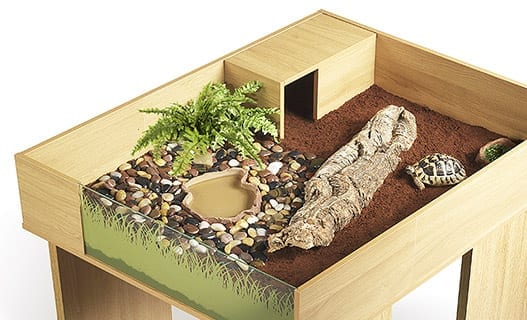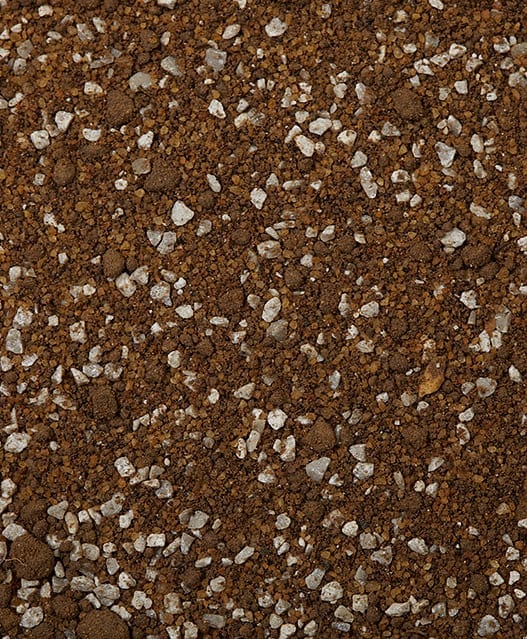Tortoises – Advanced Care
There are several species of tortoise available, however, Spur-thighed, Hermanns, Horsfields and Red Foots are good starter species for many people. They can be resilient to a variety of conditions; however, it is all keepers’ duty to provide the best care possible. We outline various ways of providing their basic needs and some hints and tips on making their lives as enriched, healthy and long lived as possible. This guide splits their care requirements into six main categories – heating, lighting, diet, substrates, hides and to begin with, housing. As it’s important to consider any species wild natural history, in particular their biotope we have included a section so that the keeper can make an informed decision on the care they provide.
Housing
There is one big debate, when considering tortoise husbandry – that is the tortoise table versus vivarium debate. Let me start by making this one area very clear – both can provide very good housing for all species – however, the vivarium will maintain a more stable temperature for the average keeper, with no detrimental effects to health or well being. It has become a well known myth that a vivarium is unsuitable for tortoises, this is simply not true. A well designed wooden vivarium – that is one that has good ventilation and a deep wooden fascia at the front will provide a young tortoise a great home. It is when they get larger that a vivarium is no longer practical. At this point we suggest an outdoor enclosure – this will provide great floor space and also access to natural sunlight.
There are many commercially available vivaria, tables and outdoor tortoise runs.

Heating
There are many relationships with the choice of heat source and lighting. This is due to the wild conditions – the sun provides both. We must keep this in mind when choosing a heat source. In the wild the sun provides a basking heat on the tortoises back, once warmed they can then go about their normal activities (feeding, breeding etc) during the daylight hours. They generally go back to their hides in the evening, or during the colder weather in the wild. In captivity this can be achieved by overhead heating (a light emitting bulb or ceramic heater) which will warm the basking tortoise below. All heaters of any kind should be controlled by a thermostat, for a non-light emitting heater a simple on/off model can be used – however, greater accuracy will be given by a pulse proportional thermostat. Any light emitting heater should be controlled by a dimming thermostat so there is no constant flashing on and off. We highly recommend the Microclimate range of thermostats. All heaters should be placed in the vivarium so there is a temperature gradient – there should be opportunity for the reptile to escape the heat. We aim for around 32-34C in the warm end, 22-24C in the cool end during the day and at night the whole vivarium can drop to around 18-20C. If the keeper is concerned their house ambient temperature drops below this during the night, there are thermostats that will control a day and night temperature – however, a light emitting heater is not recommended for use at night – a ceramic heater gives no light.
Lighting
As already discussed, in the wild tortoises normal activity levels are during the day. It is essential to get their lighting requirements correct for this reason. There are some complex requirements but the three main components for a tortoise are UVB (so they can use calcium in their diet), full spectrum (the colours of the sun) and also the illuminance level. However, a vital need is a photoperiod of at least 12 hours day to 12 hours night – this can be altered seasonally if a very natural pattern is preferred. Do not light a vivarium during the night for a tortoise – it needs to be dark, this includes coloured bulbs such as red, green and blue. Incandescent bulbs are poor as a sole source of light and are not entirely recommended. They have a very short life span, give off no UVB and have a poor full spectrum and illuminance level. Halogens are similar in many ways but a little ‘brighter’ – some keepers like to use these as basking heaters. Mercury vapour are good at giving off UVB and full spectrum and have better illuminance than an incandescent – and metal halide are better again (with some reservations, see separate lighting section). All bulbs, to some extent give off heat – this will need to be controlled by a dimming thermostat – both metal halide and mercury vapour cannot be controlled by a thermostat.
However, our preference is to provide heat separately in the form of a ceramic heater. This means that bulbs are not required – fluorescent tubes will provide the light elements required. There are two forms of tubes, an older T8 and a much better performing T5. In the older T8 tubes there are three variations – these are known as 2{cb5d0a8cf0c44aef2db327d9ab0dba08dd09aed1126b509e5fa01d3aaa87fe47}, 5-6{cb5d0a8cf0c44aef2db327d9ab0dba08dd09aed1126b509e5fa01d3aaa87fe47} and 10-14{cb5d0a8cf0c44aef2db327d9ab0dba08dd09aed1126b509e5fa01d3aaa87fe47} – this relates to the UVB output and gives an indication of the UVB power. The 2{cb5d0a8cf0c44aef2db327d9ab0dba08dd09aed1126b509e5fa01d3aaa87fe47} is best regarded as a full spectrum tube, rather than a UVB and is really designed to run along side the other two models. The 10-12{cb5d0a8cf0c44aef2db327d9ab0dba08dd09aed1126b509e5fa01d3aaa87fe47} is the best for tortoises, much depending on how close the tortoise can get to the tube (we suggest no closer than 30cm and use a 12{cb5d0a8cf0c44aef2db327d9ab0dba08dd09aed1126b509e5fa01d3aaa87fe47}). However, the newer T5 are slightly different – there is no requirement for a separate 2{cb5d0a8cf0c44aef2db327d9ab0dba08dd09aed1126b509e5fa01d3aaa87fe47} Full spectrum to run alongside the UVB. These tubes provide both. The full spectrum output is wider than a T8, and on top of that their illuminance is far superior – this means the ‘feel good factor’ for the tortoise is high. This is very important and often overlooked by keepers – it’s not just the important UVB! The UVB output of a T5 also comes in various strengths, 5-6{cb5d0a8cf0c44aef2db327d9ab0dba08dd09aed1126b509e5fa01d3aaa87fe47} and 10-14{cb5d0a8cf0c44aef2db327d9ab0dba08dd09aed1126b509e5fa01d3aaa87fe47} is the commonest.
Some keepers like to provide a UVB gradient similar to a temperature gradient; however, we suggest areas of shade and hides in the vivarium to allow regulation.
Substrates
Many forms of ground covering substrate have been tried for this species. Many keepers prefer to provide a more natural choice of a sand / soil based loose substrate others prefer sand or newspaper / carpet / lino. All have their good and bad points – but it’s fair to say that the worry of gut impaction is a topic that is fearlessly debated. We have used all methods and recommend ProRep Tortoise Life. For further reading see our advanced section on using various substrates.
Hides
Hides must be provided to allow for natural behaviour and security. These can be in the form of commercially available ones, but better to provide homemade deeper hides. This allows the reptile to regulate their exposure and choose the light level they prefer. There are many products that help with homemade hides such as Zoo Med Excavator Clay, we will add further guides in using these kinds of products in our advanced section. It’s important to remember that varying degrees of humidity will be required and that hides should be placed in various areas within the thermal gradient. If the more advanced method appeals please take a look at our guide to creating more natural humidity creating hides.
Water
A small shallow water dish should always be available.

Diet
Herman, Spur-thighed and Horsfield Tortoises eat a vast percentage of green leafy weeds and plants in their natural habitat during the cooler wetter months, dried grasses and plant material during the dryer hot months and fallen fruit during the autumn and even carrion when the opportunity arises. Red Foot tortoises originate from tropical regions with a wet and dry season and eat a high percentage of fallen fruit, carrion and mixed plant material. It’s important to recognise this difference between the species. Too much fruit in a Horsfield / Hermann / Spur-thighed tortoise diet will cause problems. We do not suggest feeding carrion to those species either; however, we do for Red Foot tortoises.
For all species of tortoises we mainly rely on weeds found naturally to provide their diet. Make sure all weeds collected are free from pesticides and are washed. Seeds can be purchased to cultivate your own weeds – we stock the ProRep seeds and kits.
Here is a list of weeds used;
Dandelion (Taraxacum officianale), Hawkbits (Leontodon spp.), Sowthistles (Sonchus spp.), Hawkweeds (Pictis spp.), Hawkbeards (Crepis spp.), Plantains (Plantago spp.), Clovers (Trifolium spp.), Honeysuckle (Lonicera periclymenum), Cat’s ears (Hypochoeris spp.), Vetches (Vicina spp.), Trefoils (Lotus spp.), Mallows (Malva spp.), Bindweeds (Calystegia spp.), Sedums (Sedum spp.), and Ivy-leaved Toadflax (Cymbalaria muralis).
We occasionally use supermarket produce such as curly kale, romain lettuce and spring greens.
For Red Foots we add a good mix of ripe fruits, and also a weekly treat of defrosted rat pups.
Hibernation (Brumation)
Spur-thighed, Hermanns and Horsfields all require a minimum of three months brumation. This is a period of stable cool temperatures of around 5-6C with dry conditions. Horsfields would also have a natural period of aestivation in the wild. Both these topics will be covered in a separate guide.
Red foot tortoises must not be hibernated.
Biotope
Spur-thighed and Hermanns tortoise both occur around Mediterranean regions occurring in a wide range of habitat, agricultural areas, around human habitation, meadows, woodland areas and rocky screes. They are active during the morning and late afternoon during the high heat of the summer.
Horsfields occur in areas throughout Asia, extending from northern parts of Iran to the former Soviet republic of Uzbekistan and northwards up into Kazakhstan. Their range extends eastwards as well, through Afghanistan and northern Pakistan as far as north-western parts of China. They occur in regions of extreme weather and very harsh conditions – terrifically high temperatures in the summer and very cold winter temperatures. They live in arid grassland rocky areas.
Red foot tortoises are a tropical species occurring in and around Panama, Venezuela, Guyana, Suriname, and Guiana, along the Andes, Colombia, Ecuador, Peru, Bolivia, Brazil, Bolivia, and Paraguay. They occur in grassland areas, usually on the fringes of woodland areas. The tropical environment provides a hot, humid environment with a wet and dry season – it has been known for this species to brumate during the dry season
This guide is designed to be used in conjunction with the help and advice given during your personal consultation at Coast to Coast Exotics. Please allow at least an hour.
